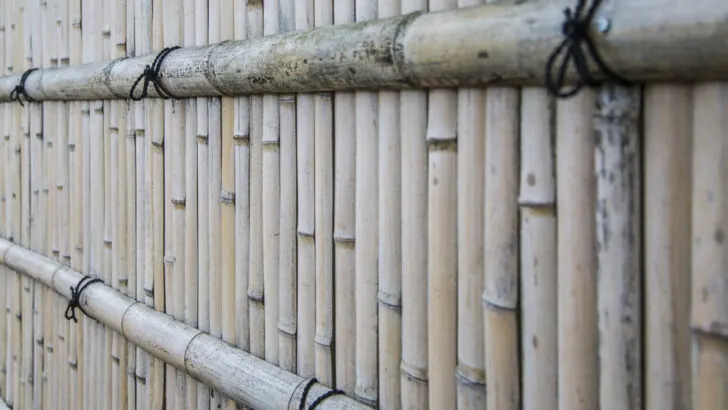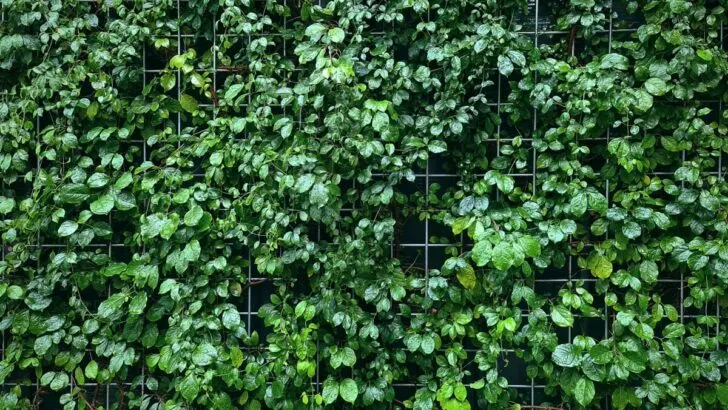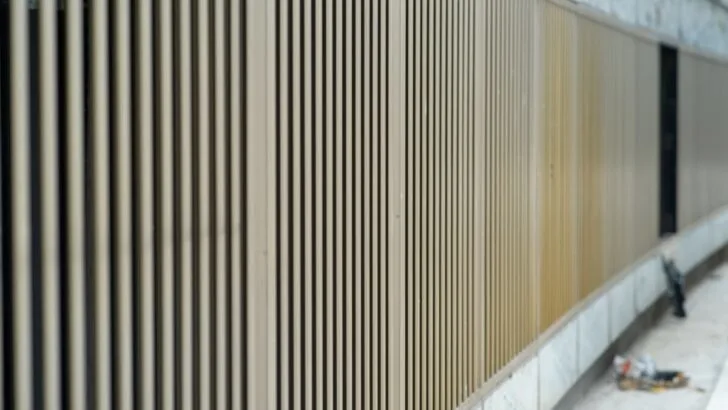If you find yourself gazing at your chain link fence, feeling less than inspired by its utilitarian appearance, you’re not alone. The good news is that transforming that dull and monotonous fence into an eye-catching and stylish feature doesn’t have to break the bank!
In this article, we’ll explore seven creative and cost-effective ways to breathe new life into your chain link fence, offering simple yet impactful solutions that will enhance your outdoor space, boost privacy, and add a touch of personality.
Whether you’re a budget-conscious homeowner or an avid DIY enthusiast, get ready to discover how a few clever techniques can turn that chain link eyesore into a stunning focal point you’ll be proud to showcase.
Chain link fence, what is it?
The most popular type of metal fence worldwide is the chain-link fence. Wire and rhombic meshes are other common names for these types of fencing. They have a zig-zag design constructed of galvanized or steel wire.
Chain link fences consist of rails, fittings, posts, and some other hardware that makes a structure that stretches a chain mesh onto it. Each part of this fence comes in a variety of coatings, thicknesses, and weights so that there are fences available for different purposes and specifications.
Moreover, there are several styles and sizes options in chain-link fences, making them appropriate for both home and business uses.
This kind of fence is also the perfect solution for temporary fencing and can act as a barrier to restrict access to an area.
Why would you need to cover a chain link fence?
Whenever you hear about chain link fences, you might have an unattractive, purely functional image in mind. But, some people see its potential for beauty in addition to its basic usefulness.
Hence, it is common for people to cover the fence with greenery or other materials so that it may liven up a place that might otherwise be dull or enlarge a limited area.
On the other hand, wind and rain may harm anything on the opposite side of a fence, so a covered wall can keep them out. It also gives individuals who live behind the fence seclusion.
Another justification is that the coverings keep the fence itself protected. If you’re in an area that has frequent weather changes, the covering helps to protect the wall from rusting.
Inexpensive materials to cover a chain link fence

1. Bamboo
An ugly chain link fence can be covered with bamboo screens, which will offer your home some privacy. With the addition of bamboo screens, a yard’s appearance can be upscaled due to its lovely aesthetic.
Moreover, bamboo plants are renowned for their hardiness, which makes them perfect for growing in the frequently harsh conditions of a fence.
Better yet, they’re quite economical and simple to install!
- To install them, first, you need to measure the length of your fence to ascertain the number of bamboo screens you’ll want.
- Next, use wire or zip ties to fasten the screens to the fence.
- Lastly, clean up the appearance by trimming any extra bamboo, and then enjoy your renovated fence!
However, due to their lower durability than other fence materials, bamboo screens may need to be changed every few years.
Furthermore, routine pruning or thinning is necessary to maintain the screen’s clean appearance because bamboo grows fast and thick.
2. Reeds
Another fantastic option to enhance the look of your home and increase seclusion is to cover a chain link fence with reed screens. However, you should first select the appropriate reeds for the task and take time to make a choice.
You’ll want something that is both appealing and durable.
After making the appropriate reed selections, measure the area you wish to cover and then buy enough to finish the project. Then, it’s time to begin putting the screens together.
Just weave the reeds in any arrangement you choose through the chain link fence. To allow for free air circulation, be sure to leave intervals between each screen.
The screens must be permanently fastened to the fence as the last stage. You may achieve this by using wire ties or staples to hold them in place.
If you decide to use staples, be sure they are small enough so they won’t stick out from behind the reeds and detract from their aesthetic appeal.
3. Privacy slats
When you need to enclose a space for privacy reasons, privacy slats are the perfect barrier material. The poles allow one to look through the screen, but due to their height, they also block one from seeing what is on the other side.
You can use them for your whole fence as they allow long, thin pieces to be put vertically.
In addition, these privacy screens are more affordable than other varieties designed especially for private spaces. Aluminum or dense polyethylene is usually used when making these fence slats.
To complement or match the color of your home, you may also spray paint them in whatever color you like.
Privacy slats are quite durable and may live for several years. About 50 years later, most of these fence slats are still in place and still provide protection. Moreover, if any slat gets damaged, it can be removed one for one.

4. Climbing plants
Growing climbing plants is a great way to hide a chain link fence if you have one. It is a less expensive alternative to purchasing a new fence while also providing your yard with more privacy.
When selecting plants to cover your fence, there are a few considerations to make. Initially, you should pick plants with an excellent climbing reputation. Clematis, Morning Glory, and Ivy are a few excellent choices.
Also, keep in mind to ensure whether the plants you select are suitable for your region’s environment.
There are several ways you may use to encourage your plants to scale your fence. One common method is by using twist ties or plant ties.
By using these, you can wrap the tie around the plant’s stem and then fasten it to the chain-link fence.
Another easier way is to simply weave the plant stems through the chain link fence. Fast-growing plants, like ivy, respond well to this technique.
Your fence will quickly be covered as the plants begin to grow!
5. Trellis
Compared to a simple chain link fence, adding a wooden trellis fence offers greater beauty and privacy!
You may make your privacy screen by joining a strong chain link fence with lightweight but robust hardwood or composite lattice or trellis panels.
- To complete this task, buy 4-by-8-foot panels and recruit the assistance of a second person to hold the boards.
- Start by ensuring the panel is flat with the chain link fence’s edge and keeping its feet off the ground.
- Then, at the center of the panel, wrap the wire around the lattice and fence.
- Twist the wire and then trim the extra using the pliers. Repeat this step on the top and bottom, left and right edges.
- Repeat the fastening procedure with another panel after positioning it next to the previous one. Continue in this way until it is all covered.
- Lastly, use wood or deck screws to attach two 1-by-4-inch boards, one on the chain link side of the fence and one on the trellis side.
This will aid in keeping your fence in place, particularly in windy places. Attach these boards both at the top and bottom of the panel and repeat this step for every panel.

6. Wood slats
One good solution to cover up a chain link fence is to add wood slats. This task is simple to complete by yourself and may prove to be a reasonably affordable way to get the appearance you desire.
To install wood slats to your chain link fence, choose the wood slats you want to use. These can be found at the majority of home improvement stores.
Make sure to buy enough slats to cover the length of your fence completely!
Measure and mark the locations where the wood slats will be attached to the fence. At these points, drill pilot holes into the fence. Start screwing or nailing the wood slats to the fence.
Ensure that the fixings on each slat are tight.
Lastly, you may apply a sealer or stain after all of the slats are in position for further protection and visual appeal.
7. Mesh privacy screens
Mesh windscreens highly resemble tarps. However, since the tarp gathers wind and behaves like a sail, it is a bad material for fencing. A mesh privacy screen, on the other hand, is designed for fences.
The mesh privacy screen has a double-thick border and brass grommets so you can zip-tie it to the chain link fence. It allows water and wind to pass through.
Depending upon the quality of the mesh, you can have privacy of range 80% to 96%.
Mesh screening is quite robust, UV-rated, and non-organic polypropylene. Therefore it should survive much longer than organic materials would.
Yet because it is made of woven fabric and is dark in color, and can ultimately become damaged by the weather.
Mesh privacy screens focus more on function than aesthetics. They need to function better for most households in terms of looks since they are frequently used in commercial spaces, schools, tennis courts, and swimming pools.
Key considerations to make before buying a fence cover
Other than these seven mentioned, there are a ton of options available to cover your fencing. Hence it can be difficult to decide which one to go for.
So, to make things easier for you, here are the key considerations for deciding which material to use to cover your chain link fence.
- Cost: Deciding on how much you are willing to spend can improve your decision-making and should settle the confusion for most. Options such as growing plants, reeds, and mesh screens are relatively inexpensive than others, but they do have the disadvantage of bad looks and, in some cases, low durability.
Hence, opting for the cheapest option available is not always the best solution; rather, try to look for a fence cover that delivers a balanced performance for its price.
- Climate: This is another important consideration to make. In the above-mentioned options, only privacy slats and mesh can be used for all types of climates since they are made of non-organic materials. Other options, such as trellis, growing plants, and reeds, do require consideration of the climate before installation.
This is because trellis, reeds, and other covers made from wood can deteriorate pretty easily in particularly wet areas. On the other hand, before planting a growing plant, make sure to check whether that particular plant can grow in your region.
- Maintenance: Generally, the most important factor that is considered when installing a fence cover is maintenance. Nobody wants to regularly spend on a chain cover after some period of time. Chain link covers such as bamboo, reeds, and growing plants require maintenance after regular periods.
On the other hand, privacy slats, trellises, and wood slats also require maintenance but not very frequently. Therefore, someone that doesn’t want to be bothered about their fence covers should choose these options, but if you’re willing to accept the trade-off, you can opt for the other ones.
Final Words on Inexpensive Ways to Cover a Chain Link Fence
To sum it up, chain link fences can be covered using a variety of inexpensive materials. Bamboo and trellis are mostly used for their aesthetics.
Climbing plants and reeds are utilized due to them being cheap, whereas wood slats, privacy slats, and mesh provide the benefit of being durable and less maintained. However, all of them provide their unique characteristics and looks.
Hence, the decision of which one to choose depends on your preference or the factors discussed above.
Moreover, covering up your chain link fence can prove to be a good idea. They first help to maintain privacy and enhance the aesthetics of your yard or house. They are also used to prevent small children and animals from getting through the fence.
Further, they also protect the chain link fence itself, as these fences are generally quite prone to damage.
If you found this article helpful, make sure to take at some of the other fence-related posts below!


